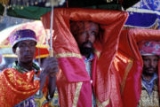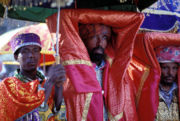
Tabot
Encyclopedia

Ge'ez language
Ge'ez is an ancient South Semitic language that developed in the northern region of Ethiopia and southern Eritrea in the Horn of Africa...
(as well as Ethio-Semitic
Ethiopian Semitic languages
Ethiopian Semitic is a language group, which together with Old South Arabian forms the Western branch of the South Semitic languages. The languages are spoken in both Ethiopia and Eritrea...
) word referring to a replica of the Tablets of Law, onto which the Biblical
Bible
The Bible refers to any one of the collections of the primary religious texts of Judaism and Christianity. There is no common version of the Bible, as the individual books , their contents and their order vary among denominations...
Ten Commandments
Ten Commandments
The Ten Commandments, also known as the Decalogue , are a set of biblical principles relating to ethics and worship, which play a fundamental role in Judaism and most forms of Christianity. They include instructions to worship only God and to keep the Sabbath, and prohibitions against idolatry,...
were inscribed, used in the practices of the Ethiopian Orthodox Church
Ethiopian Orthodox Tewahedo Church
The Ethiopian Orthodox Tewahedo Church is the predominant Oriental Orthodox Christian church in Ethiopia. The Ethiopian Church was administratively part of the Coptic Orthodox Church until 1959, when it was granted its own Patriarch by Coptic Orthodox Pope of Alexandria and Patriarch of All...
. Tabot can also refer to a replica of the Ark of the Covenant
Ark of the Covenant
The Ark of the Covenant , also known as the Ark of the Testimony, is a chest described in Book of Exodus as solely containing the Tablets of Stone on which the Ten Commandments were inscribed...
. The word tsellat (Ge'ez: ጽላት ṣallāt, modern ṣellāt) refers only to a replica of the Tablets, but is less commonly used.
According to Edward Ullendorff
Edward Ullendorff
Edward Ullendorff FBA was a British scholar and historian, especially in Semitic languages and Ethiopia.-Biography:...
, the word tabot is derived from the Jewish Aramaic
Aramaic language
Aramaic is a group of languages belonging to the Afroasiatic language phylum. The name of the language is based on the name of Aram, an ancient region in central Syria. Within this family, Aramaic belongs to the Semitic family, and more specifically, is a part of the Northwest Semitic subfamily,...
, or more specifically the Aramaic, word tebuta (tebota), which in turn is derived from the Hebrew
Hebrew language
Hebrew is a Semitic language of the Afroasiatic language family. Culturally, is it considered by Jews and other religious groups as the language of the Jewish people, though other Jewish languages had originated among diaspora Jews, and the Hebrew language is also used by non-Jewish groups, such...
tebah. "The concept and function of the tabot represent one of the most remarkable areas of agreement with Old Testament forms of worship."
A tabot is usually six inches (15 cm) square, and may be made from alabaster
Alabaster
Alabaster is a name applied to varieties of two distinct minerals, when used as a material: gypsum and calcite . The former is the alabaster of the present day; generally, the latter is the alabaster of the ancients...
, marble
Marble
Marble is a metamorphic rock composed of recrystallized carbonate minerals, most commonly calcite or dolomite.Geologists use the term "marble" to refer to metamorphosed limestone; however stonemasons use the term more broadly to encompass unmetamorphosed limestone.Marble is commonly used for...
, or wood from an acacia
Acacia
Acacia is a genus of shrubs and trees belonging to the subfamily Mimosoideae of the family Fabaceae, first described in Africa by the Swedish botanist Carl Linnaeus in 1773. Many non-Australian species tend to be thorny, whereas the majority of Australian acacias are not...
tree -- although David Buxton states the maximum length of 40 cm is more common. It is always kept in ornate coverings to hide it from public view. In an elaborate procession, which has often reminded literate onlookers of the sixth chapter of 2 Samuel where King David
David
David was the second king of the united Kingdom of Israel according to the Hebrew Bible and, according to the Gospels of Matthew and Luke, an ancestor of Jesus Christ through both Saint Joseph and Mary...
leads the people dancing before the Ark, the tabot is carried around the church courtyard
Courtyard
A court or courtyard is an enclosed area, often a space enclosed by a building that is open to the sky. These areas in inns and public buildings were often the primary meeting places for some purposes, leading to the other meanings of court....
on the patronal feast day, and also on the great Feast of Timket (known as Epiphany or Theophany in Europe). Buxton describes one such procession, on the festival of Gabra Manfas Qeddus
Gabra Manfas Qeddus
Gabra Manfas Qeddus was an Ethiopian Christian saint, and the founder of the monastery of Zuqualla. The fifth day of every month in the Ethiopian calendar is dedicated to this saint....
:
- To the uninstructed onlooker the climax of the service came at the end, when the tabot or ark was brought out, wrapped in coloured cloths, carried on the head of a priest. As it appeared in the doorway the women raised the ililUlulationA is a long, wavering, high-pitched vocal sound resembling a howl with a trilling quality. It is produced by emitting a high pitched loud voice accompanied with a rapid movement of the tongue and the uvula. The term ululation is an onomatopoeic word derived from Latin...
, a prolonged and piercing cry of joy. At first the tabot remained motionless, accompanied by several processinal crosses and their attendant brightly colored canopies, while a group of cantors (dabtara) performed the liturgical dance so beloved of the Abyssinians. The dancing over, a procession formed up, headed by the tabot, and slowly circled the church three times in a counter-clockwise direction. Finally the tabot was carried back into the sanctuary; all was over and the assembly broke up.
Although Ethiopia
Ethiopia
Ethiopia , officially known as the Federal Democratic Republic of Ethiopia, is a country located in the Horn of Africa. It is the second-most populous nation in Africa, with over 82 million inhabitants, and the tenth-largest by area, occupying 1,100,000 km2...
was never colonized by the British, many tabots were looted by them during the 1868 Expedition to Abyssinia
1868 Expedition to Abyssinia
The British 1868 Expedition to Abyssinia was a punitive expedition carried out by armed forces of the British Empire against the Ethiopian Empire...
, which is a cause of anger among Ethiopians. During the looting of the Ethiopian capital of Magdala
Amba Mariam
Amba Mariam is a village in central Ethiopia. It was known as Magdala or Meqdela during the reign of Emperor Tewodros II of Ethiopia...
in 1868, British soldiers took hundreds of tabots. The return in February 2002 of one of these, discovered in the storage of St. John's Episcopal Church in Edinburgh
Edinburgh
Edinburgh is the capital city of Scotland, the second largest city in Scotland, and the eighth most populous in the United Kingdom. The City of Edinburgh Council governs one of Scotland's 32 local government council areas. The council area includes urban Edinburgh and a rural area...
, was a cause of public rejoicing in Addis Ababa
Addis Ababa
Addis Ababa is the capital city of Ethiopia...
.
Further reading
- C.F. Beckingham and G.W.B. Huntingford, "Appendix III, The Tabot" in their translation of Francisco Alvarez, The Prester John of the Indies (Cambridge: Hakluyt Society, 1961), pp. 543-8.

